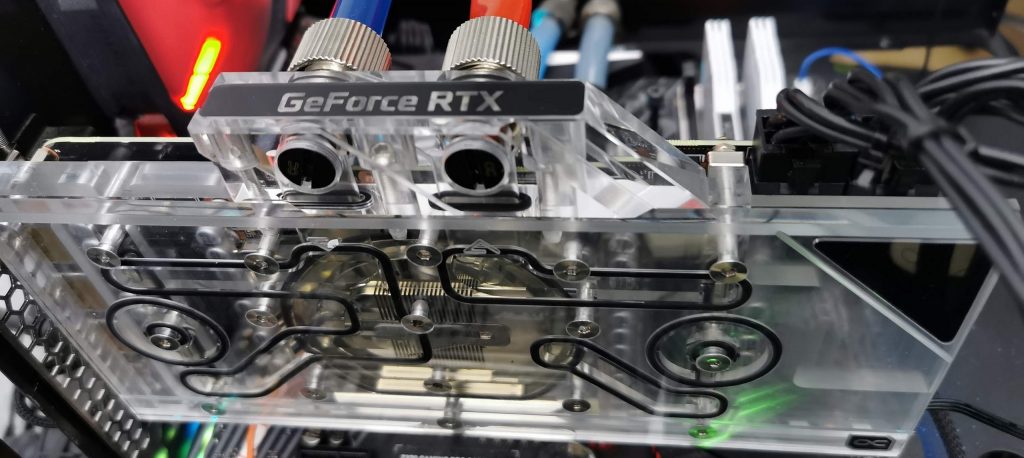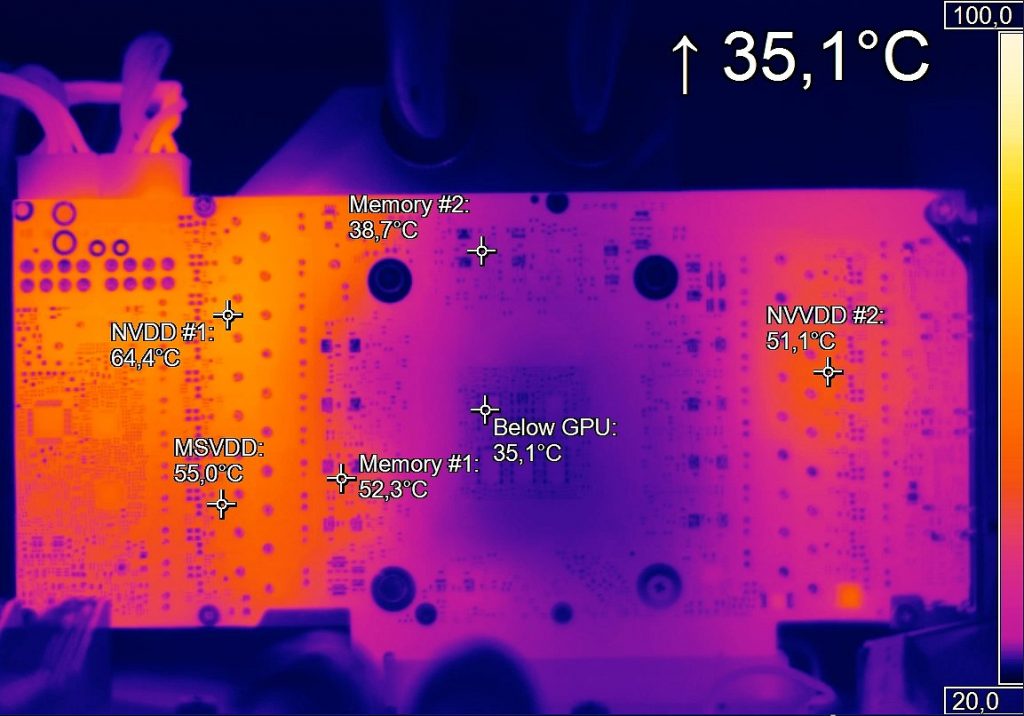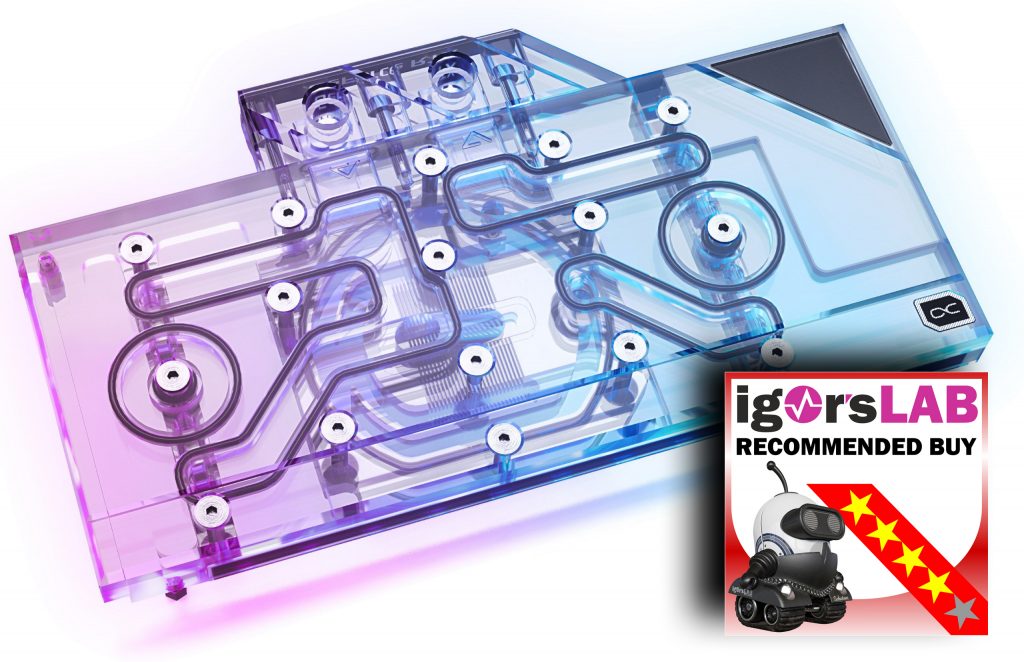Let’s now move on to the measurement, where I rely as always on the central laboratory cooling system with the chiller and another expansion tank. Pure, distilled water is used, which is filtered at regular intervals. The water temperature is kept at a constant 20 °C, which makes it much easier to determine the absolute temperatures and deltas. The internal GPU diode measures from about 19 °C chip temperature reasonably reliably, below that it quickly becomes inaccurate. Room temperature and water temperature are thus also approximately the same, which avoids dangerous condensation.
Temperatures are recorded using an engineering tool for the GPU diode and the substrate temperature of the GDDR6X (hotspot) and with the help of a calibrated, high-resolution industrial camera for infrared measurements. Here the PI640 from Optris with a normal focal length is used. The camera has a 640 x 480 pixel bolometer to detect thermal radiation. For the evaluation I record a radiometric video, which I can later read out as required.
| Test System and Equipment |
|
|---|---|
| Case: |
Lian Ti T70 (modified) |
| Monitor: | Alphacool Eiszeit 2000 Chiller, 20l additional reservoir |
| Power Consumption: |
Oscilloscope-based system: Non-contact direct current measurement on PCIe slot (riser card) Non-contact direct current measurement at the external PCIe power supply Direct voltage measurement at the respective connectors and at the power supply unit 2x Rohde & Schwarz HMO 3054, 500 MHz multichannel oscilloscope with memory function 4x Rohde & Schwarz HZO50, current clamp adapter (1 mA to 30 A, 100 KHz, DC) 4x Rohde & Schwarz HZ355, probe (10:1, 500 MHz) 1x Rohde & Schwarz HMC 8012, HiRes digital multimeter with memory function MCU-based shunt measuring (own build, Powenetics software) NVIDIA PCAT and FrameView 1.1 |
| Thermal Imager: |
1x Optris PI640 + 2x Xi400 Thermal Imagers Pix Connect Software Type K Class 1 thermal sensors (up to 4 channels) |
| OS: | Windows 10 Pro (2004, all updates, current certified drivers, NVIDIA 456.55) |
Now the cooler must prove itself! In the slightly regulated circuit with about 100 l/h I let the cooler sweat at 340 watts and Witcher 3 in Ultra-HD for one hour. You have to allow yourself this time, because only after a longer period of time all areas of the board are completely warmed up.
The measurement result for the GPU is really impressive. A full 9 degrees between the water and the GPU is the lowest delta I’ve ever measured on a GPU water block in this performance class! The value of 29 °C shown below is thus a new record. The GDDR6X gets a maximum of 72 °C internally in the hotspot, which fits loosely.
You shouldn’t be irritated by the clock rate, because I increased the power limit to 340 watts for a constant load, but not the boost clock rate. This reduces the spikes and the power consumption remains constantly high. Of course, I monitored that these 340 watts are also converted.
But what is the result of the thermal measurement of the back of the board? Nothing negative, as you can see at first glance. The hottest spot on the GDDR6X is quickly found and yes, it is again the known approx. 20 degree difference between substrate and back of the board. This also shows that this can now almost be considered a rule of thumb.
You can see here in the video what could be achieved with the cooler as maximum. Because up to 2.2 GHz with 25 to 28 degrees GPU temperature are really a board. But you can see in the video how much it varies. Therefore the Witcher 3 and a very constant load for the final measurements. But first let’s have a quick look at our lovely Lara:
However, these full load temperatures are all in the deep green range, there is still well over 30 degrees air up to the thermal throttling of the special micron modules. This temperature results from the heating of the board, also due to the tracks of the voltage supply running at this point.
The other temperatures are also impressive, even those of the hard working NVVDD voltage converters. On the test card used, unfortunately, only the rather cheap DrMOS from Alpha & Omega were used, which, as 50-A models, are loosely sufficient, but cannot break any records for efficiency. This then manifests itself in a slightly higher waste heat, which is actually an advantage on such a test system. But with plenty of 64 °C at the hottest spot after one hour, there are no problems in sight.
If the canal above had been wider at this point and if attempts had been made to include further areas, it would certainly have been possible to gain up to 5 degrees. The same applies to the backplate, which can also provide significant thermal relief for the VRM. And we can also see why I thought that you might not want to cool the memory on the backside with the backplate. A delta of 12 degrees (and more) between the modules and VRM could also be counterproductive and unintentionally form a kind of thermal bridge.
Summary and conclusion
The Alphacool Aurora Plexi GPX-N RTX 3090/3080 GPU water block deserves a real buying tip simply because of the really excellent low GPU temperature. Now all that remains is to find the matching cards. But that in turn is not the problem of Alphacool, who can at least deliver, but of NVIDIA. The memory temperatures are good and a lot of air remains at the top. The slightly higher VRM temperatures in one area are solely due to the design of the water circuit, but even at maximum OC, they are never a cause for concern. it all still fits perfectly.
The most important area, namely the GPU and RAM, remained absolutely flawless and I have never been able to measure such a low delta. The 9 degrees at 340 watts is a really high benchmark for all subsequent coolers. So let the water games begin! Let’s see who dares to send me something else 🙂





































Kommentieren